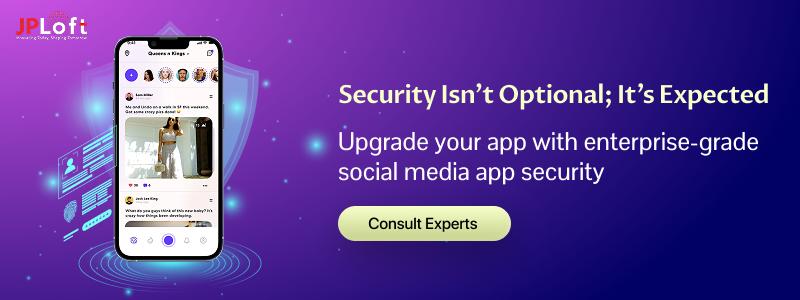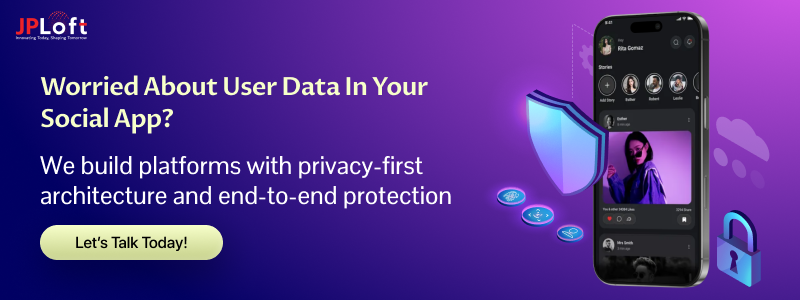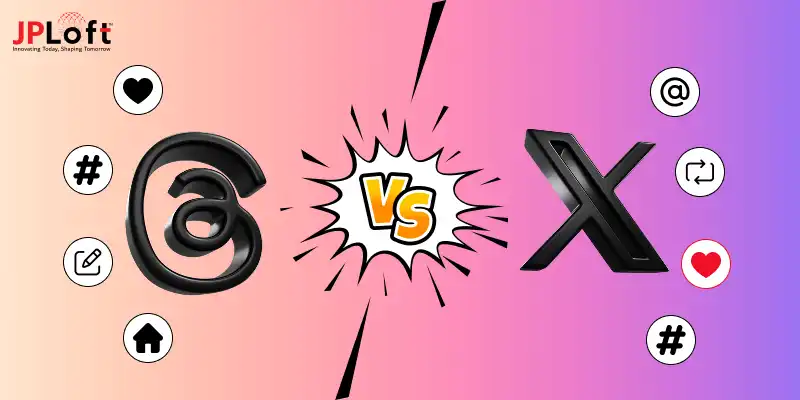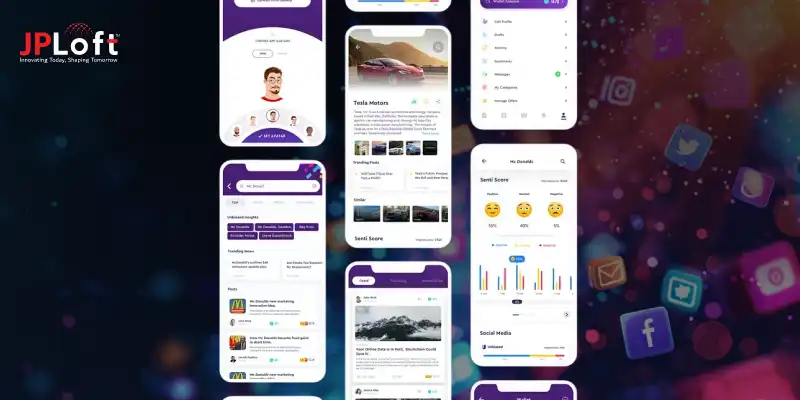In 2025, building a social media app isn’t just about features and followers; it’s about trust. One breach, and everything crumbles: user confidence, brand reputation, and even legal standing.
But why is social media app security non-negotiable in 2025? Social media apps handle sensitive data, personal content, and real-time interactions every day. Without strong security, they’re exposed to breaches, legal trouble, and user backlash.
This blog unpacks why securing your app matters more than ever, what threats are out there, and how to stay compliant while keeping users safe. Whether you’re launching a startup or scaling fast, you’ll find clear answers, real examples, and smart security practices right here.
Let’s get into it.
Key Takeaways:
Social media app security is non-negotiable in 2025. Data breaches hurt trust, invite legal trouble, and damage your brand.
Top threats include phishing, weak APIs, and fake accounts. Address them with encryption, secure logins, and access control.
Apps must comply with GDPR, CCPA/CPRA, and DPDP. Follow global privacy laws and platform-level security standards.
Secure apps use AI and ML to detect threats. Automation helps flag suspicious activity and block attacks in real time.
Startups must build privacy-first platforms from day one. Security should be part of your architecture, not a patch after launch.
How is the Social Media App Market Growing in 2025 and Beyond?
The social media app landscape is entering a hyper-secure, innovation-driven era as users demand greater control over privacy and platforms face increasing regulatory pressure.
Here’s a snapshot of how this space is evolving in 2025 and beyond:
-
The global social media market is projected to reach $1.5 trillion by 2030, growing at a CAGR of 10.9% from 2025 to 2030, driven by monetization features, niche platforms, and AI-enhanced user experiences.
-
As per social media market statistics, mobile-first social media apps are expected to contribute over 75% of total user engagement by 2026, with privacy-focused design becoming a competitive differentiator.
-
The global cybersecurity market is projected to reach $500.7 billion by 2030, growing at a CAGR of 12.9% from 2025 to 2030, as industries, including social media, increase investment in fraud detection, AI moderation, and user data protection.
-
Over 6.2 billion users will be active on social media by 2026, with rising concerns around identity theft, fake profiles, and content manipulation.
These statistics reinforce that social media app security will define platform success in the years ahead, not just UX or engagement.
Users concerned about privacy are increasingly exploring Discord alternatives that offer more secure, community-driven experiences.
Others are shifting to Snapchat alternatives for more control over ephemeral content and digital identity.
Security-first design is now a key factor influencing rankings among the best social media apps.
Let’s now explore why securing a social media app is no longer optional in the next section.
Why Secure Social Media Apps in 2025?
Social media platforms today are more than networking tools; they’re data goldmines. And in 2025, that makes them a magnet for cyber threats. Here’s why securing your social media app is no longer optional:
A] One Breach Can Break Everything
A single cyberattack can wipe out user trust, damage your brand’s reputation, and cost you millions in fines or lawsuits. That’s one big reason why many social media apps fail soon after launch.
B] Security Is a Business Priority
Data protection isn’t just about compliance; it’s a growth driver. When users feel safe, they stay longer and engage more. Are you planning to build a privacy-first platform? Then don’t ignore the cost to develop an app like MeWe, especially if security is a top priority from day one.
C] Startups Are More Vulnerable
Early-stage apps often skip security due to budget or time. That shortcut results in bugs, breaches, and scalability problems, some of the biggest social media app development challenges startups face.
D] Your Users Expect Protection
Today’s users are smarter. They demand encrypted messaging, secure logins, and privacy transparency. Fall short, and they’ll switch to platforms that deliver on those expectations.
Bottom line? In 2025, building the most secure social media app isn’t just a backend concern; it’s a front-line competitive advantage.
Top Security Threats Social Media Apps Must Watch in 2025
In 2025, social media apps will face smarter, faster, and more targeted attacks than ever. If you're developing a platform, here are the biggest risks you need to address:
1. Phishing and Fake Accounts
Attackers are using AI to create ultra-realistic fake profiles and phishing links that trick users into revealing credentials or financial information. These scams can spread fast, harming both users and your platform’s credibility.
2. Weak API Security
Insecure APIs are a top entry point for hackers. If not protected properly, they can expose user data or enable account hijacking. Fixing poor API design later can significantly increase your social media app development cost.
3. Poor Access Controls
Many breaches happen because apps don’t implement proper authentication layers; think weak passwords, missing two-factor authentication, or exposed admin panels. These flaws can be exploited to gain backend access.
4. Vulnerable Third-Party Integrations
Plugins, SDKs, or external tools might save time, but if they’re outdated or poorly coded, they open the door to data leaks and malware. That’s why users seeking safer messaging options often turn to Skype alternatives.
5. Data Monetization Risks
Apps that store user behavior or monetize personal data are major targets for cybercriminals. If you rely on ad revenue or personalized recommendations, you’ll need to secure that pipeline. Here’s where you must rethink how social media apps make money without compromising data integrity.
Bonus Insight: In 2025, social media mobile app security must go beyond passwords, encompassing secure API calls, encrypted session storage, and device-level authentication to guard users on the go.
Tackling these risks early means fewer breaches, more user trust, and smoother compliance down the road.
Compliance and Regulations to Follow in Social Media App Security
Security isn’t just about firewalls and encryption; it’s about compliance, too. In 2025, regulatory pressure is rising worldwide, and if your social media app mishandles user data, it’s not just bad PR; it’s a legal nightmare.
Here are the must-follow compliance and regulatory standards for any serious social media platform:
► GDPR (General Data Protection Regulation)
If your app targets or processes data from users in the EU, GDPR compliance is non-negotiable. This includes clear data collection practices, cookie transparency, and allowing users to delete their data.
► CCPA & CPRA (California Privacy Laws)
For U.S.-based apps or those with California users, CCPA and its upgraded sibling, CPRA, require you to disclose data usage, enable opt-outs, and handle data access requests quickly.
Apps that grow globally will need to keep pace with evolving social media app development trends, many of which focus on built-in compliance from day one.
► India’s DPDP Act (Digital Personal Data Protection Act)
If your app collects data from Indian users, the new DPDP Act requires explicit consent, proper data storage, and authorized processing protocols. Violations can lead to major financial penalties.
► Platform-Level Security Standards
Google Play, Apple App Store, and Meta all enforce their own data handling and privacy standards. Ignoring these may result in app rejection or takedown.
► UI/UX Compliance Matters Too
Secure design isn’t just about what happens behind the scenes. Your app should communicate policies clearly and minimize “dark patterns.” Understanding how to design a social media app with privacy-first UX is now a compliance requirement in many markets.
► Cross-Border Data Transfer Rules
Apps hosting or transferring data internationally must implement standard contractual clauses, data localization (where required), and transparent consent logs. This is especially true if you're working on international expansion or looking at the cost to develop an app like Instagram; global rules will apply.
Staying compliant isn’t a one-time thing; it’s a continuous effort. And with every country tightening data privacy rules, baking compliance into your app architecture is a smart, future-proof move.
Real-World Cases That Prove Why Social Media App Security Matters
You don’t have to look far to see what happens when social media apps ignore security. From small missteps to billion-dollar disasters, real-world examples show how one breach can ruin everything.
Here are a few security lapses that made headlines and why they matter to your app:
► Facebook’s 533 Million-User Leak
In 2021, personal data of 533 million Facebook users, including phone numbers and full names, was leaked online. The issue? A vulnerable contact importer feature. This could’ve been prevented with better security filters and tighter access controls.
What does this teach us? Missing or underdeveloped security functionality isn't just a product gap; it's a liability. Make sure your social media app features include robust authentication, data encryption, and abuse prevention.
► Clubhouse API Exposure
The invite-only audio app Clubhouse quickly rose to fame, but its public API allowed scraping of user profiles and chat room metadata. Even without passwords being leaked, the event triggered major trust issues.
One reason Clubhouse struggled to bounce back? It lacked experienced security engineers early on. That’s why startups now prefer to hire dedicated developers who can implement security-first architecture from day one.
► TikTok Vulnerabilities Uncovered by Researchers
TikTok has faced several security concerns, from exposed user data to session hijacking risks. In one case, a vulnerability could let hackers manipulate content on users’ profiles.
While TikTok patched it fast, it raised the bigger question: what if the bug had gone unnoticed? This is one of the many reasons why social media apps fail: reactive security instead of proactive planning.
Lesson? These failures weren’t just technical oversights. They missed opportunities to build user trust, and in some cases, they nearly cost the platforms their growth.
Best Practices to Secure a Social Media App in 2025
Securing a social media app in 2025 isn’t just about slapping on a password wall. It’s about creating a full-stack defence from backend APIs to user-facing features that evolve as fast as the threats do.
Here are the top practices every developer, product owner, or startup founder should follow to lock down their platform and build long-term user trust:
1. Start with Secure Architecture
Security must be part of your app’s DNA, not an afterthought. Begin with a privacy-by-design approach: secure APIs, limited data access, encrypted storage, and modular code that can scale without exposing vulnerabilities.
If you’re in the early stages of planning, it’s worth studying how to create a social media app with security-first principles integrated from the start.
2. Enable Multi-Factor Authentication (MFA)
Weak or reused passwords are still the top reason for unauthorized access. Make MFA standard, whether it’s via OTP, biometrics, or device confirmation, to ensure better login protection.
3. Automate Threat Detection Using AI
Security threats evolve in real time, and static rules can’t keep up. More platforms are now integrating AI development services to detect suspicious logins, DDoS attempts, scraping, or unusual user behavior. AI can also help reduce false positives, keeping the experience seamless for genuine users.
4. Train Smarter Defense with ML
Machine learning complements AI by helping systems learn from past attack patterns and improve their threat response. From spam detection to anomaly tracking, ML development services play a critical role for creating a most secure social media app.
5. Work with Experts, Not Generalists
Security is not the place to cut corners. Many startups now collaborate with the best mobile app development company to integrate AI and ML-driven threat detection early in the dev cycle, ensuring long-term scalability and data protection.
6. Build Security into Your Business Roadmap
Security isn’t just a dev concern; it’s a leadership mindset. If you're figuring out how to start a social media business, security needs to be part of your go-to-market plan, not a post-launch patch. Users trust platforms that make safety a priority, not an afterthought.
Bottom line? Great social media apps aren’t just functional; they’re secure from the inside out. These practices help you stay ahead of threats, retain user trust, and scale confidently in a competitive space.
Build a Secure Social Media App with JPLoft’s Expertise
If you're serious about building a secure, scalable, and user-trusted social media platform, you can’t afford to treat security as an afterthought.
At JPLoft, we build more than just beautiful apps; we engineer platforms with security at the core, backed by real-time protection, scalable infrastructure, and future-ready compliance.
Whether you’re starting from scratch or scaling fast, our team of experts knows what it takes to build resilient systems from encrypted messaging to secure API integration, AI-based threat detection, and beyond.
Not sure where to begin? JPLoft offers a full guide to social media app security tailored to startups and scaling businesses.
Looking for a reliable social media app development company that understands both the product and the protection side? You just found it.
Let’s talk about building your next secure social media app the right way.
Conclusion
Building a social media app without strong security is like leaving your front door open; eventually, someone’s going to walk in.
From user privacy to platform integrity, social media app security impacts every part of your product and business. In 2025, the risks are higher, and users are more aware of how their data is handled.
The good news? Securing your app doesn’t require a complete overhaul; it just requires the right mindset and a solid plan. With smart practices, AI-driven tools, and the right development support, you can launch confidently and scale without fear.
Whether you're releasing your first version or expanding your platform, one thing’s clear: the social media apps that win are the ones users trust to protect them.
FAQs
Social media app security means using tools and best practices to protect user data and app integrity. It matters because these apps store personal info and private conversations, prime targets for cyber threats. This social media app security guide gives a quick overview of how to stay secure.
The most common threats include phishing attacks, data leaks, fake accounts, weak API protections, and unauthorized access to user data. These vulnerabilities can lead to serious legal, financial, and reputational damage if not addressed early.
Start by integrating security at the architecture level; think encrypted databases, secure APIs, and multi-factor authentication. Add AI-based threat detection, automated moderation, and regular security audits to stay proactive.
It doesn’t have to be. While adding advanced security features increases your upfront investment, it saves significant costs in the long run by preventing data breaches, user churn, and regulatory penalties.
Yes. Depending on your target regions, you may need to comply with laws like GDPR (EU), CCPA (California), or India’s DPDP Act. Your app must have proper consent flows, data encryption, and deletion policies in place to meet these requirements.
AI can detect unusual patterns like bot activity, suspicious login attempts, or content abuse in real time. It reduces manual workload and allows faster response to evolving threats, making your platform safer without affecting the user experience.













Share this blog